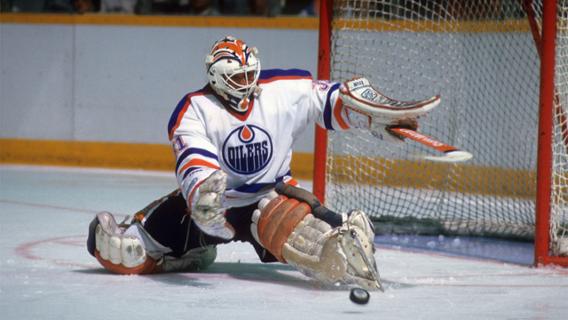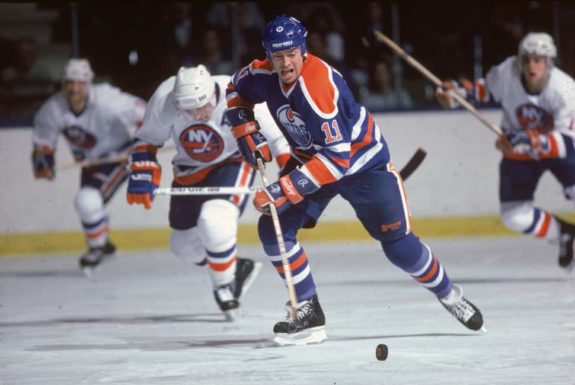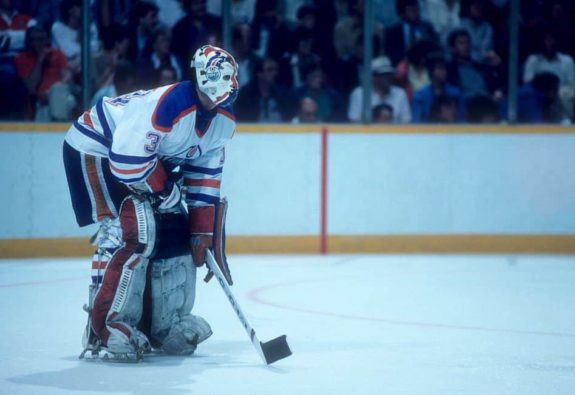The response was swift and harsh and not even the cat-like reflexes of Grant Fuhr could stop it.
On Sept. 27, 1990, NHL president John Ziegler imposed a one-year suspension – without pay – on the Edmonton Oilers’ goaltender after he admitted to using an illegal “substance” in an interview with the Edmonton Journal, which detailed his use of cocaine in the 1980s.
Sign up for our NHL History Substack newsletter
In the Aug. 31 article, Fuhr confessed to illegal drug use, stating his sporadic binges occurred between 1983 and 1989 but never amounted to an addiction. (from ‘HOCKEY; Fuhr Used Cocaine, Paper Says,’ New York Times, 09/01/1990) When Fuhr’s agent, Ritch Winter, urged him to take a private drug test, a positive result prompted Fuhr to check into a Florida drug treatment center, where he was treated for cocaine abuse in the summer of 1989.
After rehab, Fuhr maintained that he stayed clean in the year leading up to his suspension and Oilers general manager Glen Sather vouched for his star netminder, saying he tested negative for cocaine on three occasions during that time.
The Suspension Announcement
Ziegler released a 10-page statement explaining the suspension, which was based on a season-long ban levied against Don Murdoch of the New York Rangers in 1978. Murdoch had also been in violation of the league’s drug policy after he was arrested for cocaine possession though his penalty was eventually reduced to 40 games.
The NHL took into account Fuhr’s efforts to address his substance abuse problem and to remain drug-free for a year, but ultimately determined that the repeated and deliberate violation of league rules had to be punished: “His conduct went on for a period of six to seven years. It went on in spite of a clear league policy that if you use illegal drugs you will be suspended,” said Ziegler in his statement. “Mr. Fuhr’s actions were intentional and were in defiance of this policy. He must suffer the consequences.”

The suspension was the second-longest in NHL history. Only Billy Coutu’s lifetime ban for assaulting two referees and sparking a Stanley Cup bench-clearing brawl in 1927 was longer. That penalty was reduced after two-and-a-half years but Coutu never laced up in the NHL again.
The NHL reinstated Fuhr on Feb. 18, 1991 after the Vezina Trophy winner missed 59 games. The initial ruling allowed for the suspension to be reduced if the Oilers appealed and Fuhr showed that he “did not conduct himself in a manner to have caused dishonor or prejudice to the league,” according to a New York Times article. (from ‘Fuhr Reinstated by N.H.L.,’ New York Times, 02/05/1991)
In commuting the suspension of the star netminder, Ziegler said “the information provided to me is most convincing that Mr. Fuhr has met the conditions for reinstatement.”
When Fuhr returned from a conditioning stint in Cape Breton, Nova Scotia, played well down the stretch and into the playoffs for the Oilers.
The Hall of Famer was the fifth NHL player to be suspended for drug use. Ric Nattress of the Montreal Canadiens was handed a one-year ban after being convicted of drug possession in 1983 but, as was the case with Fuhr and Murdoch, he had his penalty reduced and only missed 30 games. Toronto Maple Leafs defenseman Borje Salming and Detroit Red Wings’ tough guy Bob Probert missed less playing time for their cocaine-related infractions.
Reaction to the Fuhr Suspension
Criticism of the suspension was immediate from Sather and Fuhr’s teammates. “We don’t agree with it and we think it was much too harsh,” the Oilers’ GM told members of the media after the ruling.
Forward Craig MacTavish called the NHL’s decision punitive, but one that would do nothing to help players struggling with substance abuse issues:
“I mean really, what was Grant guilty of?” MacTavish asked reporters. “He was guilty of having a problem, and he was trying to remedy that problem. If that’s a cause for suspension, what kind of message does that send to the rest of the league? If you’ve got a problem, don’t seek help, just continue to do it quietly and you’ll be able to play hockey.”
Oilers’ captain Mark Messier echoed MacTavish’s sentiments and even urged the league to create more effective regulations regarding drug use.

“We definitely have to come out of the ice ages and come up with some sort of drug policy,” he said in Jeff Z. Klein’s biography, Messier. “Obviously what we have right now suppresses people from coming forward and trying to get help … if our policies had been different perhaps ten years ago, this might not have happened.”
Messier also suggested the next collective bargaining agreement should contain improved drug treatment regulations that did more to assist players in need of help.
Focusing on Drug Treatment
It didn’t take long for Messier and his fellow NHL players to have the opportunity to voice their opinions about the league’s lack of a drug rehabilitation program. The NHL Players’ Association (NHLPA) voted overwhelmingly to go on strike on April 1, 1992 — but instead of focusing on substance abuse, the major issues were playoff bonuses, changes to the free agency system and licensing rights for hockey cards, which provided major revenues at the time.
When the strike was resolved 10 days later, little headway had been made on a new drug rehabilitation program.
You may also like:
- Oilers’ Skinner in Line for Vezina Trophy Winning Season
- Oilers: 8 GMs Who Would’ve Been Better Hires Than Stan Bowman
- NHL Rumors: Oilers, Maple Leafs, Capitals, Kuznetsov News
- Edmonton Oilers’ Point Projections for 2024-25
- Edmonton Oilers Name Stan Bowman General Manager
The NHL and the NHLPA did, however, implement a Substance Abuse and Behavioral Health (SABH) program in 1996, which remains in place to this day. It is a four-stage confidential program that provides education, counselling, medical treatment and after-care assistance to players, who can voluntarily seek help without informing the NHL or the NHLPA of any substance abuse issues. The doctors who operate the program decide if suspensions, fines or other penalties are required for players who violate the terms of their treatment. Players continue to receive their full NHL salary and can often continue playing while they are in the program. Continued breaches of conditions can lead to suspensions without pay.
It was a program that Messier’s New York Rangers teammate Theoren Fleury entered into in 2001, though it would take several years for the former Calgary Flames winger to get a handle on his demons.
Fuhr’s Reaction to NHL Drug Policies
The regulatory changes were welcomed by Fuhr, who praised the NHL for no longer being so focused on player punishment during a 2014 interview with the Globe and Mail. (from ‘Grant Fuhr shows comfort in life and decisions in new book,’ Globe and Mail, 10/31/2014)
“It’s like night and day now because the NHL now will help players, where when I got suspended it was about punishment,” he said. “It wasn’t about rehabilitating players or helping them get better in life, it was about punishing them. I think the NHL has gone leaps and bounds in getting better at that where they’ve got programs in place now and they actually will help players before they get themselves in trouble.”

The five-time Stanley Cup champion also discussed the suspension in the documentary Making Coco, which recently made its world premiere in Toronto. He reiterated in the documentary, which will close the Calgary International Film Festival on Sept. 29, that the NHL was more interested in making his case punitive: “They weren’t sure what to do,” Fuhr says in the film. “I think they determined, ‘OK, well, we’re here to punish, we’re not here to help anybody.'”
Evolution of NHL Drug Policies
In addition to upgrading “recreational” drug regulations, the NHL’s performance-enhancing penalties have also evolved over the years. The following disciplinary steps were introduced by the NHL and the NHLPA in 2005:
- 20-game suspension without pay and referral to the SABH program for evaluation/treatment following a first positive drug test.
- 60-game suspension without pay after a second positive test for a banned substance.
- Permanent suspension from the NHL, with eligibility to apply for reinstatement after two years, following a third positive test for performance enhancers.
Mandatory testing for performance-enhancing substances was introduced in 2006, exposing players to a minimum of two drug tests per year without warning.
More attention has returned in recent years to recreational drugs, such as cocaine and marijuana.
NHLPA officials started noticing an increase in players testing positive for cocaine use in 2015 and in 2016 the league and the Players’ Association agreed to start checking all samples of drug-tested NHLers for recreational drugs.
In a TSN story about the policy shift, NHL deputy commissioner Bill Daly discussed the rising number of players testing positive for cocaine.
“I wouldn’t say it’s a crisis in any sense,” Daly told TSN. “What I’d say is drugs like cocaine are cyclical and you’ve hit a cycle where it’s an ‘in’ drug again.
“I’d be shocked if we’re talking about a couple dozen guys. I don’t want to be naive here … but if we’re talking more than 20 guys I’d be shocked.”
The NHL’s rules and regulations governing drug and alcohol abuse have evolved significantly since Fuhr was slapped with his year-long suspension. It’s unlikely a player in his position would feel as blindsided as Fuhr did decades ago.

